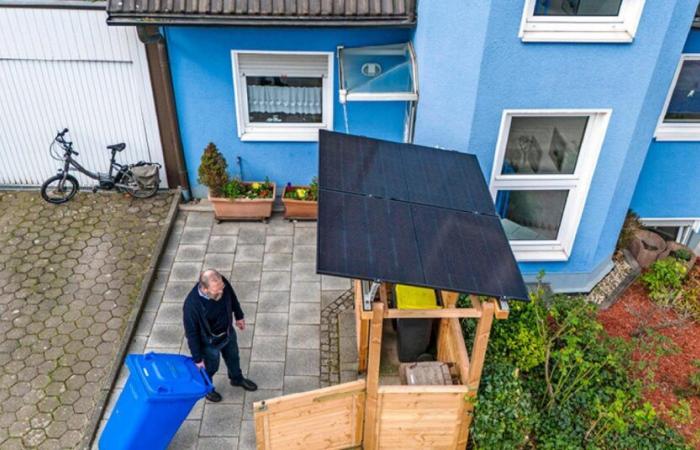Soon authorized in Belgium, these low-cost photovoltaic panels have advantages, but also quite a few disadvantages.
At first glance, the concept seems great. A solar kit to install yourself in just a few minutes on your terrace, your balcony, a carport or a guardrail. Low-cost photovoltaics, still banned in Belgium, will be authorized from April 17, 2025as it is already with our French, German or Dutch neighbors for years. The principle is simple: you just need to plug the panel into an electrical outlet which will itself supply the circuit on which it is located. “In practice, the mobile photovoltaic panel sends direct current to a microinverter which will transform it into alternating current to inject it into a socket on a circuit to which other sockets are connected,” explains Jean Frippiat, from the site d news dedicated to renewables renouvelle.be. If nothing is connected to this circuit, the electricity will continue its way to the electrical panel which can distribute it to other circuits in the house according to needs.
Currently, this is not possible, because technical prescription C10/11 from Synergid, the spokesperson for the sector of gas and electricity network managers, requires that solar installations be directly connected to the electrical panel of the home via a fixed connection. In five months, it will be authorized. An individual can purchase their double 400 Watt plug&play panel with its integrated microinverter and inclined support for around 600 to 700 euros, and install it themselves. Prices have already fallen. In France, this summer, Lidl offered a kit at 370 euros. In Germany, where these panels have been authorized since 2021, there are 400,000 of them in operation, according to Euronews, or 4% to 5% of the country’s total solar power. In the first half of 2024 alone, the Germans have installed more than 200,000.
In Belgium, will it be interesting to invest in this type of installation? For testachats, the investment may be worth it for households on a budget and renters who, when they move, can take the equipment with them. For others, a calculation is necessary. Ideally oriented (south, south-east, south-west), two panels with a power of 400 Watts crete (Wp) ultimately cost around 1.2 euros/Wp. This is a little lower than for a classic roof panel, the price of which is around 1.4 euros/Wp in Wallonia for an installation of at least ten panels. In France, prices are higher for a classic roof panel, between 1.8 and 2 euros/Wp. Investing in a plug&play kit is therefore more advantageous than with us.
As for the performance of low-cost solar panels, it logically depends on the orientation in relation to the sun but also on the inclination. Even with guidance facing south, we already lose 30% of yield between an inclination of 35° and one of 90°. If the balcony, for example, is located in the shadow of another building for part of the day, this also plays a role. For now, the return on investment can vary, depending on the parameters, from seven to eleven years. Note that with plug&play, we recommend self-consumption even more than with roof panels. But that remains relative. “Two 400W panels would cover a little more than 10% of the electricity needs of an average household,” says Jean Frippiat. With a traditional roof installation of around ten panels, the same household, whose consumption amounts to around 3,000 kW, can cover, thanks to self-consumption, from 30% to 40% of its needs.
Low cost solar panels to declare
The difference is that you cannot install ten panels on your balcony, the most popular place for plug&play. In France, the power authorized for these low-cost kits is also limited to 800 W per home, i.e. two 400 W panels (the most common power per panel). In Belgium, the federal government must still study the matter, between now and April, and define the maximum power authorized in the General Regulations for Electrical Installations (RGIE). It is likely that its choice is the same as among our French neighbors, for safety reasons related to electrical installations individuals and the general network. The RGIE could also impose an inspection to certify the conformity of the connection. You will then have to add around 150 euros to the final bill.
In addition, users will have to declare their installation to their network and distribution manager (GRD). Those who are not not yet equipped with a smart meter will have to do so (free in all regions of the country under certain conditions). This will allow, in particular, as with conventional panels, to be compensated for unused current which is injected into the network, provided that the supplier is notified. For signs visible from the street, you should also go to the town planning office to check if a permit is required.
Will low-cost solar panels one day replace traditional panels? “I don’t believe it and it’s not desirable,” says Francesco Contino, energy expert and professor at the UCLouvain polytechnic school. These moving signs can never be so well placed compared to the sun than on a roof. In terms of cost and performance, it is not that relevant, even as a backup solution. Solar power is a very good alternative to fossils, but we might as well focus on the most effective solutions. For apartment owners, before considering installing one, it seems more judicious to me to first check with the co-ownership if we cannot invest collectively in a traditional installation on the roof of the building.”
Another point of attention raised by testachats, plug&play panels risk aging more quickly. Indeed, often placed at eye level, they are more exposed to shocks. The same goes for the cables, if they are not properly hooked. This can reduce their lifespan quite considerably.






